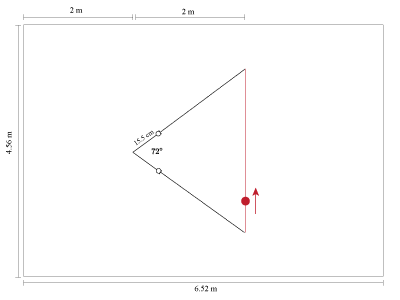Audio samples
The simulated space has the same dimensions as our audio booth: 6.52x4.56x2.10 m. The source and the microphone array are positioned as shown in the figure below, at a height of 1.05 m. The microphone array is a stereophonic subset of our patented array for base-angle 72deg and radius 15.5cm. It is assumed that the stereophonic loudspeaker setup you are using to play back the samples has roughly 72deg base-angle. The source is moving back and forth on a line as deicted in red in figure. The original audio sample is Archimedes's anechoic percussion.
As a first sample, the walls have realistic frequency-dependent absorption. More specifically, the floor is cotton carpet, the ceiling is fissured tiles while the walls are walls, hard surfaces average, as reported in M. Vorlander's book. Here you can find the audio sample:
https://desena.org/sdn/realistic_walls.wav
As a second example, the walls have frequency-independant absorption, which changes over time. For the first 5 seconds the room is perfectly anechoic. Between 5 and 10 seconds, the walls have a reflectiveness of 0.75, which then increases to 0.85 between 10 and 15 seconds. Finally, at 15 seconds the reflectiveness is further increased to 0.9. Here you can find the audio sample:
https://desena.org/sdn/changing_reflectiveness.wav
